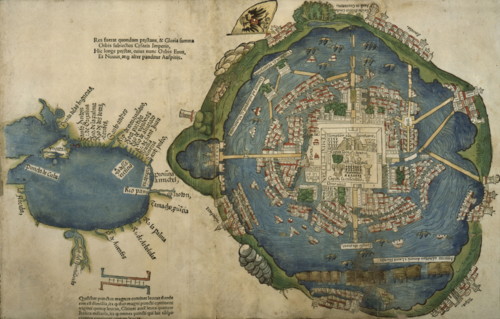And yet, it should be remembered that the world population in 1500 was only 500 million compared to the 7 billion alive today. The largest city in the world in 1500 was Beijing, China with 625,000 people. At the time, Tenochtitlan was in the middle range of the world’s ten largest urban centers tied with cities both still existent, and whose fame has been long forgotten, cities such as Hangzhou in China, Tabriz in Iran, and glorious Istanbul. Only one Western city could be numbered among the largest cities in the world in 1500, Paris with a population of 185,000.
The great artist from Nuremberg, Albrecht Dürer, who lived during this time of Western discovery and initial conquest of the New World, had the opportunity to set his eyes on some of the stolen treasures of Aztec civilization. Certainly, they must have come as a shock. The genius Dürer found something both familiar and utterly alien. The universal character of art he could comprehend, while at the same time the mythological language and culture that gave context to the art was incomprehensible within the not only the Christian world-view, but from the view point of any of the cultures, ancient or modern, he might have known. Only the works of Ancient Egypt might have appeared so wondrously baffling. In 1520 Dürer wrote of seeing the Aztec treasures:
All the days of my life, I have seen nothing that rejoiced my heart so much as these treasures, for I saw among them wondrous works of art, and I marveled at the subtle Ingenia of men in foreign lands. Indeed I cannot express all that I thought there.
It is not definitively known whether the account of Cortez’s conquest of the Aztecs, especially its beautiful illustrations of Tenochtitlan, such as the one above, influenced Dürer’s short work on fortified cities published in 1527, (illustration below) but the more than superficial similarities, timing, and his interest in the Aztec’s all suggest this may be the case. If Tenochtitlan did indeed influence Dürer’s idea of fortified cities it would be somewhat ironic, for he was expressing not just his own utopian ideal, but offering what he thought was a practical remedy for Turks on the march against Hungary. In basing his fortifications on Tenochtitlan, Dürer was using a city that had fallen to a handful of Spaniards and their allies almost overnight.
Dürer’s fortress cities remained a mere flight of imagination for all but one instance: the Black Forest town of Freudenstadt designed by the architect Heinrich Schickhardt, which was explicitly based on the designs of Dürer. Freudenstadt folds us firmly back into the utopian tradition, for the town was an immediate influence on J.V. Andreae’s Christianopolis , another idealized city and utopia (pictured below) that remained a mere thing of the mind.
All of this brings us back to Tenochtitlan. For the Spanish conquest of the city signaled the beginning of the rise of the West. The momentum of urbanization shifted there, especially with the beginning of industrialization around 1800. All of the world’s largest cities, save one, were located in the West by 1900: London, New York, Paris, Berlin, Chicago, St. Petersburg, and Philadelphia. The one exception was Tokyo, a consequence of the fact that Japan alone among non-Western societies had fully embraced industrialization.
As has always been the case, with cities came all the momentum in art, architecture, literature, science, technology. This was the Venetian sunset of our civilization. In the 21st century the momentum of civilization has again shifted back to the non-Western world. Like Paris at the beginning of the modern era, New York stands alone as a representative of the West among the world’s ten most populous cities. Mexico City, the heir of Tenochtitlan, is back where it once was among the world’s largest cities. With this shift, the creative energies of humanity are likely to move away from the West and towards the great cities of the wider world. A person in Europe or America can only patiently wait for the art of “foreign lands” to blow their mind like the Aztec’s blew the mind of Dürer, or for the ideal city to be re-imagined somewhere outside of our civilization, and perhaps, this time, even formed.



